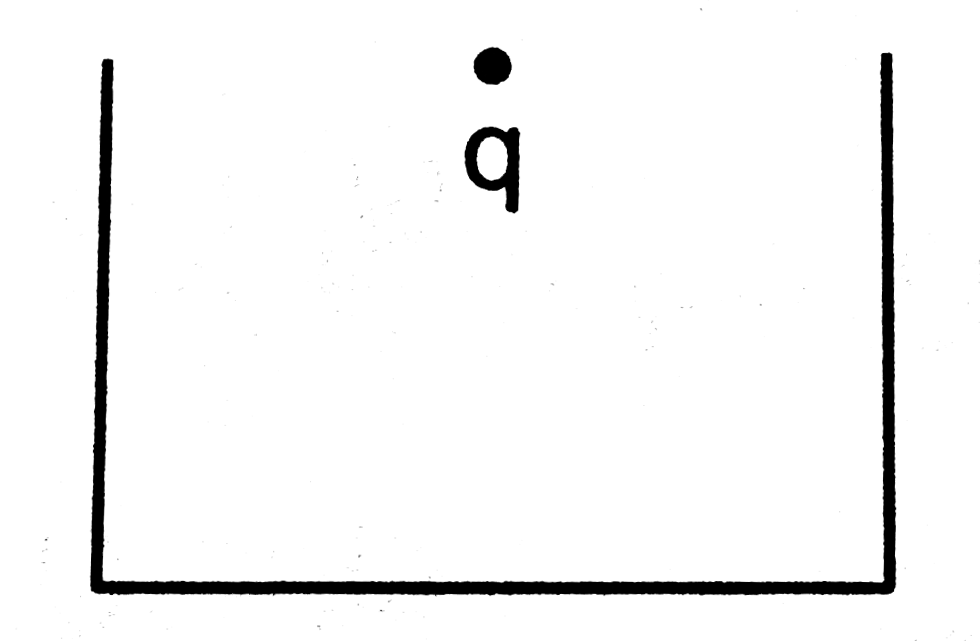A point charge q is placed on the apex of a cone of semi-vertex angle θ. Show that the electric flux through the base of the cone is q(1−cosθ)/2ε0.
 .
.
Method 1 : For point charge, the Gaussian surface should
be spherical. Consider a Gaussian sphere with its center at the
apex and radius the slant length of the cone. The flux through
the whole sphere is q/ε0. Therefore, the flux through the base
of the cone is ϕE=(A/A0)q/ε0. Here, A0 is the area of the
whole sphere (4πR2), and A is the area of the sphere below the
base of the cone. Consider a differential ring of radius r and
thickness dr, then
dA=(2πr)Rdα=(2πRsinα)Rdα(asr=Rsinα)
A=∫θ0(2πR2)sinαdα=2πR2(1−cosθ)
The desired flux is
ϕE=(AA0)1ε0=(2πR2)(1−cosθ)4πR2(qε0)
=(1−cosθ)q2ε0
Method 2: The total solid angle around a point in space is 4π
steradian. The solid angle subtended by the base of the cone
at the apex of the cone is (2π(1−cosθ)). As the flux associated
with solid angle 4π is q/ε0 , the flux associated with the solid
angle 2π=(1−cosθ) is
ϕ=qε02π(1−cosθ)4π=q(1−cosθ)2ε0.
Topper's Solved these Questions
- BOOK - CENGAGE PHYSICSCHAPTER - ELECTRIC FLUX AND GAUSS LAWEXERCISE - Exercise 2.116videos
ELECTRIC FLUX AND GAUSS LAW
- BOOK - CENGAGE PHYSICSCHAPTER - ELECTRIC FLUX AND GAUSS LAWEXERCISE - Exercise 2.214videos
ELECTRIC FLUX AND GAUSS LAW
- BOOK - CENGAGE PHYSICSCHAPTER - ELECTRIC FLUX AND GAUSS LAWEXERCISE - MCQ s38videos
ELECTRIC FLUX AND GAUSS LAW
- BOOK - CENGAGE PHYSICSCHAPTER - ELECTRIC CURRENT AND CIRCUITEXERCISE - Interger8videos
ELECTRIC CURRENT AND CIRCUIT
- BOOK - CENGAGE PHYSICSCHAPTER - ELECTRIC POTENTIALEXERCISE - DPP 3.514videos
ELECTRIC POTENTIAL
Similar Questions
A point charge q is placed on the apex of a cone of semi-vertex angle θ. Show that the electric flux through the base of the cone is q(1−cosθ)/2ε0.
 . View Solution
. View Solutionpoint charge q is placed on the top of a cone of semi vertex angle theta .The electric flux through the base of the cone is
View Solution
Knowledge Check
- Question 1 - Select One
a point charge q is placed at the centre of a cylinder of length L and radius R the electric flux through the curved surface of the cylinder is
Aqε0L√L2+R2Bqε0L√L2+2R2Cqε0L√L2+4R2Dq2ε0 - Question 2 - Select One
An electric charge q is placed at the centre of a cube of side l. The electric flux through one of its faces will be
AQε0Bq6ε0Cqε0l2Dq4πε0l2 - Question 3 - Select One
Electric flux through a cube with charge q inside is
Aqε0Bq6ε0Cq3ε0D0
A charge q is placed at the centre of a cube of side l what is the electric flux passing through two opposite faces of the cube ?
View SolutionA charge q is placed at the centre of a cylinder of radius R and length 2R. Then electric flux through the curved surface of the cylinder is
View SolutionA point charge q is placed at the centre of a cube of side length a .The electric flux emerging from one of the face of cube is
View SolutionA point charge Q is placed at one of the vertices of a cubical block. The electric flux flowing through this cube is
View SolutionA charge q is placed at the centre of the open end of a cylindrical vessel . The flux of the electric field through the surface of the vessel is
 View Solution
View Solution

